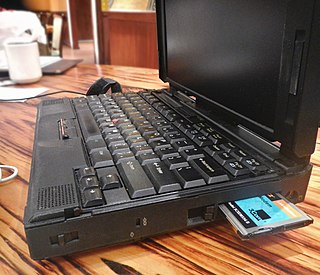 W
WA motherboard is the main printed circuit board (PCB) in general-purpose computers and other expandable systems. It holds and allows communication between many of the crucial electronic components of a system, such as the central processing unit (CPU) and memory, and provides connectors for other peripherals. Unlike a backplane, a motherboard usually contains significant sub-systems, such as the central processor, the chipset's input/output and memory controllers, interface connectors, and other components integrated for general use.
 W
WIn computer architecture, a bus is a communication system that transfers data between components inside a computer, or between computers. This expression covers all related hardware components and software, including communication protocols.
 W
WThe capacitor plague was a problem related to a higher-than-expected failure rate of non-solid aluminium electrolytic capacitors, between 1999 and 2007, especially those from some Taiwanese manufacturers, due to faulty electrolyte composition that caused corrosion accompanied by gas generation, often rupturing the case of the capacitor from the build-up of pressure.
 W
WIn a computer system, a chipset is a set of electronic components in an integrated circuit known as a "Data Flow Management System" that manages the data flow between the processor, memory and peripherals. It is usually found on the motherboard. Chipsets are usually designed to work with a specific family of microprocessors. Because it controls communications between the processor and external devices, the chipset plays a crucial role in determining system performance.
 W
WVIA EPIA is a series of mini-ITX, em-ITX, nano-ITX, pico-ITX and pico-ITXe motherboards with integrated VIA processors. They are small in size and consume less power than computers of comparable capabilities.
 W
WExpressCard, initially called NEWCARD, is an interface to connect peripheral devices to a computer, usually a laptop computer. The ExpressCard technical standard specifies the design of slots built into the computer and of expansion cards to insert in the slots. The cards contain electronic circuits and sometimes connectors for external devices. The ExpressCard standard replaces the PC Card standards.
 W
WA front-side bus (FSB) is a computer communication interface (bus) that was often used in Intel-chip-based computers during the 1990s and 2000s. The EV6 bus served the same function for competing AMD CPUs. Both typically carry data between the central processing unit (CPU) and a memory controller hub, known as the northbridge.
 W
WThe term Legacy Plug and Play, also shortened to Legacy PnP, describes a series of specifications and Microsoft Windows features geared towards operating system configuration of devices and IDs are assigned by UEFI Forum. The standards were primarily aimed at the IBM PC standard bus, later dubbed Industry Standard Architecture (ISA). Related specifications are also defined for the common external or specialist buses commonly attached via ISA at the time of development, including RS-232 and parallel port devices.
 W
WMonokub is a computer motherboard based on the Russian Elbrus 2000 computer architecture, which form the basis for the Monoblock PC office workstation.
 W
WNonvolatile BIOS memory refers to a small memory on PC motherboards that is used to store BIOS settings. It is traditionally called CMOS RAM because it uses a volatile, low-power complementary metal-oxide-semiconductor (CMOS) SRAM powered by a small "CMOS" battery when system and standby power is off. It is referred to as non-volatile memory or NVRAM because, after the system loses power, it does retain state by virtue of the CMOS battery. The typical NVRAM capacity is 256 bytes.
 W
WIn computing, PC Card is a configuration for computer parallel communication peripheral interface, designed for laptop computers. Originally introduced as PCMCIA, the PC Card standard as well as its successors like CardBus were defined and developed by the Personal Computer Memory Card International Association (PCMCIA).
 W
WThe Personal Computer Memory Card International Association (PCMCIA) was a group of computer hardware manufacturers, operating under that name from 1989 to 2009/2010. Starting with the eponymous PCMCIA card in 1990, it created various standards for peripheral interfaces designed for laptop computers.
 W
WQ-Connector or ASUS Q-Connector, is an adapter, sometimes included with ASUS motherboards, which sits in between the motherboard front panel connectors and the front panel cables. The Q-Connector is marked with bigger text than the front panel connectors on the motherboard, as well as protruding from the motherboard, limiting obstruction from heatsinks and other connectors.
 W
WA riser card is a printed circuit board that picks up a multitude of signal lines via a single connector on a motherboard and distributes them via dedicated connectors on the card.
 W
WSam440, also known by Sam or its codename Samantha, is a line of modular motherboards produced by the Italian company ACube Systems Srl. The Sam440ep version is a motherboard based on the PowerPC 440EP system-on-a-chip processor which includes a double-precision FPU. It is made by AMCC. Their primary targets are the industrial and embedded markets, running operating systems such as Linux and AmigaOS 4.
 W
WSam460ex is a line of modular motherboards produced by the Italian company ACube Systems Srl. The machine was released in October 2010 and can run AmigaOS 4, MorphOS, or Debian GNU/Linux.
 W
WThe STEbus is a non-proprietary, processor-independent, computer bus with 8 data lines and 20 address lines. It was popular for industrial control systems in the late 1980s and early 1990s before the ubiquitous IBM PC dominated this market.